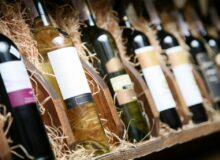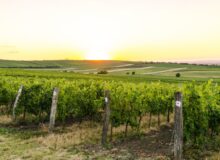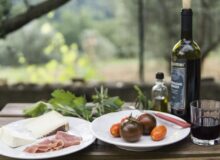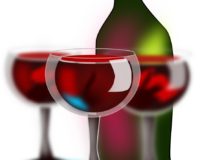A lot of people get confused with Bordeaux and sure there is a lot that can be learned and said about this famous wine place; enough for an encyclopedia. This is a paradise for these grapes with all kinds of different soils and weather. This place is the benchmark for quality that is the reference point to all wine. In this quick guide I will keep it very very simple… I put together a pronunciation chart and a tasting chart that’s posted that can be downloaded as well.
The main Reds are Cabernet Sauvignon, Merlot, Cabernet Franc and Petit Verdot. The main Whites are Sauvignon Blanc, Semillon and Muscadelle. The whites produced in Bordeaux are both sweet and dry.
The great wine areas of Bordeaux are St.- Estephe, Pauillac, St.-Julien, Margaux, Graves and Passac-Leognan, St. Emillon, Pomerol, Sauternes/Barsax and a bunch of other smaller excellent Satellite Apellations.
For a quick list…Guys/Gals that you can call about French Wines are The Bern’s Steakhouse (they have the most incredible legendary cellar) and B-21’s in the Tampa area. Total Wine is another one to consider because they do carry plenty of French wine.
The Reds:
Cabernet Sauvignon is dark and tannic . It can be very astringent and provide the backbone for a wine. It can ripen late because of its think skin can be herbaceous, have cedar and tobacco nuances. You can often taste blackberries and dark plums among other flavors. It can age well.
Merlot ripens late as well but quicker than Cabernet sauvignon. It is often a lot softer than Cabernet Sauvignon and provides a chewy, supple round feel to the wine. It is usually bended with and is less acidic and tannic Cabernet Sauvignon. You can drink Merlot based wines a lot earlier but can age just as well.
Cabernet Franc is not very powerful. Yet it has a hot and sharp-tasting quality to it. It has a black olive hint to it as well as this wild grassy flair that when blended makes flavors and bouquet of the wine prism. It’s usually used in smaller quantities for influencing weight of the wine.
Petit Verdot is an intense wine with puckering tannins. It can be tasty and high in alcohol. It is very dark and not very easy to grow during harvest of Bordeaux because it ripens very late. If it is picked to early it can be extremely bitter which can throw off a wine. It is not used in some places in Bordeaux.
The Whites:
Sauvignon Blanc is used for making the dry wines that you find in Graves and the sweet wines that you find in Sauternes. It is a grape with a lot of minerality. It is grassy to the nose and is crispy. In Sauternes it is used to blend with Semillon in making the sweet wines.
Semillon is a grape that is fat! It is creamy with a lot of smoothness. It is used to make the legendary sweet wines of Sauternes and Barsac. The older it gets the more gelatinous it gets. It’s fruity too. It is also used to provide texture to the dry wines in Graves.
Muscadelle is a concentrated and ornamental grape that is used sparingly in Barsac and Sauternes and sometimes Graves. It is hard to grow because its can get sickly because it is so fragile but it gives off these great tropical flavors.
Some quick comments on the great wine areas of Bordeaux. Now keep in mind these just observations…
St.- Estephe are firm, bold but very easy-to-read. They are fairly tannic and full bodied. They have an rigid austere quality which is good for aging.
Pauillac wines are among my favorites because they are medium to full bodied with black fruits, rich, powerful and have hints of tobacco and cedar.
St.-Julien have a good juicy currant fruit characteristics. They are mellower. They can be spicy with cedar notes
Margaux wines have great floral perfume representation. They are often more delicate and lighter than the St.-Estephe wines. Margaux wines are earthy and they have a lot of Cabernet Sauvignon and are very good young too.
Graves and Passac-Leognan wines have lingering taste that is toasty, earthy with tobacco, cedar and clay. You can taste the limestone and clay. They are very aromatic, light yet with deep flavors. The white wines are oaky and creamy
St. Emillon wines are herbaceous and juicy. Often mouthwatering with soft fruit They use more Merlot and Cabernet Franc in the blends. Those grapes grow really well in St.-Emillon. The wines take on a lot of styles it seems. It makes the searching and the tasting enjoyable. A lot of new modern winemakers have been making wine in St.-Emillon which is cool.
Pomerol wines are the benchmark for Merlot based wines. Black cherries and cassis flavors abound. These wines can be velvety smooth. The wines are round and have a polished air to them not found in other areas; quite frankly in the world. There is a small production from Pomerol.
Sauternes/Barsac can range from honey and tropical fruits, sweet zesty citrus all the way to Graham crackers and pine nuts even flan/crème brulee. The taste can feel like glycerin. It can be extremely glamorous
The Satellite Appellations are where you find the best values. Whether it is Cannon-Fronsac, Lalande de Pomerol, Cotes de Bourg, Blaye, and Cotes de Castillon. These appellations are providing some of the most exciting wines of the past 10 years and are giving the classic areas a challenge because they make great appealing wines in an uncomplicated manner which is attractive to wine makers and producers. The consumers like this too. What’s not to like!?! This is where you find the overachievers and incredible sleeper wines that are good to drink within the first 5 years.









